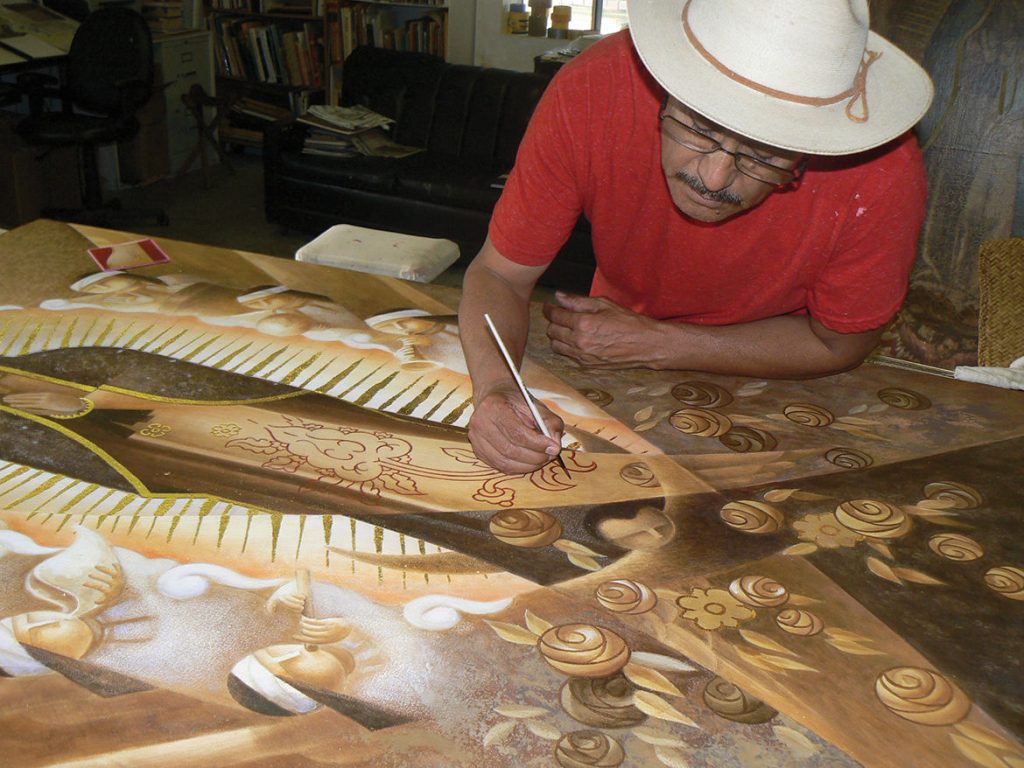Lalo Garcia’s voice was reflective: “I first learned of Blessed Junípero Serra through history books about his building the California missions.” Having spent the first 13 years of his life in Mexico, young Lalo was familiar with stories of missionary priests.
And now Garcia has been commissioned by Los Angeles Archbishop José H. Gomez to paint an official portrait of the soon-to-be canonized Junípero Serra, the Apostle of California, for the Cathedral of Our Lady of the Angels.
“My first impression of Padre Serra was that he was just another friar determined to convert the natives of California to Catholicism. His story is similar to that of Don Vasco de Quiroga, a friar who came to the people of Michoacan, my native state, and the Jesuit priest, Eusebio Kino, who evangelized Sonora.”
Garcia’s artistic career began in a roundabout way. As a teenager in the San Fernando Valley, he attended an art school “for fun” but really didn’t pay much attention. Not understanding English very well, he did factory work until, at the age of 22 while also attending Valley College, he accidently signed up for a calligraphy course.
“My teacher liked my work and introduced me to the owner of a sign shop. He was looking for apprentices,” Garcia chuckled at the memory. “I stayed there for 12 years.”
While making signs, he founded the Grupo Folklorico Fiesta Mexicana dance company, which performed traditional Mexican dances throughout the United States and Mexico, including a tour with Linda Ronstadt.
Father John Jensen of the Archdiocese of Los Angeles saw the dance troupe perform and hired its founder to coordinate various events at Dodger Stadium.
“Learning that I had designed the dance company’s costumes, Father Jensen brought me to the attention of the owners of Martinez and Murphy. As it turned out they were looking for an in-house designer. They hired me on the spot.”
Martinez and Murphy was a liturgical art and sacred environment company heavily involved with the archdiocese during the 1980s and into the 2000s.
Garcia now spends much of his time painting.
“I do landscapes and portraits but they are not my specialty,” he said with a shrug. “I prefer easel paintings, though I’m a muralist on occasion, and I’ve had the opportunity to design stained glass windows, statuary, jewelry, furniture and vestments, including those worn by Pope St. John Paul II and the bishops concelebrating Mass with him in 1987 at Dodger Stadium.”
In 2005, Garcia met a man who came to mean a great deal to him, master artist and muralist Frank Martinez, who, coincidentally, had been commissioned to paint a mural of Padre Serra. Through him, Garcia got to know more about the Franciscan.
“In my studio, as he created the mural for the cathedral, Frank would talk about Father Serra, passionately describing incidents in his life saying, ‘He will always be my hero.’
“Frank made it plain that Father Serra was a man of God, convinced of the importance of what he had to do; that introducing the Catholic faith in Upper California was a gift from God which Serra had to deliver. Despite his poor health, teaching the Indians about the love of God was his reason to always move forward. Father Serra was a holy man and did everything he could to better the lives of everyone who lived in the missions.”
Born Nov. 24, 1713, Miguel Josep Serra y Ferrer entered the Franciscan Order in 1730 and took the name “Junípero” after Brother Juniper, the good-humored friend of St. Francis of Assisi. He was ordained in 1737.
After becoming a successful and popular teacher of theology and philosophy at Majorca, Father Serra took a ship to Mexico City, arriving Jan. 1, 1750. He spent the next eight years in missionary work among the Pame Indians and another eight years in administrative work in Mexico City.
In 1767, Serra became head missionary in Baja California. The following year, the Spanish Empire decided to extend its administration to Alta California. Happily volunteering to join what was called the Sacred Expedition, Father Serra spent his remaining 15 years in charge of establishing the Catholic faith in Alta California.
Beginning in San Diego, Serra founded the first nine of the state’s 21 missions along what was called El Camino Real, “The King’s Highway,” much of which is now the Hollywood Freeway (101).
Garcia pointed out, “Serra personally supervised building missions San Buenaventura, San Gabriel and San Carlos Borromeo in Carmel where he died and where his body is buried. I wanted to have these three of the nine he was responsible for building as elements of composition for my painting along with an image of Our Lady of Guadalupe, to whom Serra was devoted while stationed in Mexico City.”
The Franciscan friar willingly sacrificed a successful career to bring Christ to the New World, dying Aug. 28, 1784. On Sept. 23, during his visit to the United States, Pope Francis will raise the Franciscan friar to the altar as Saint Junípero Serra.

